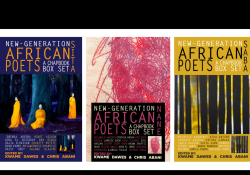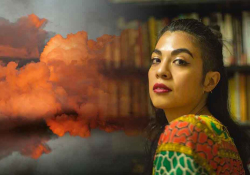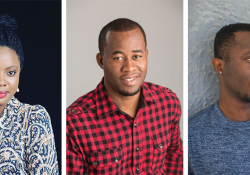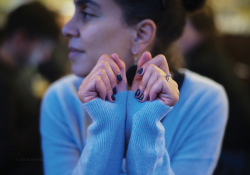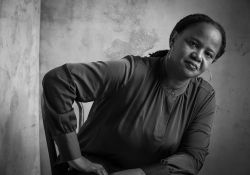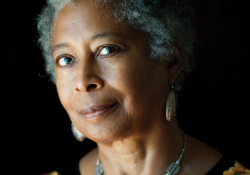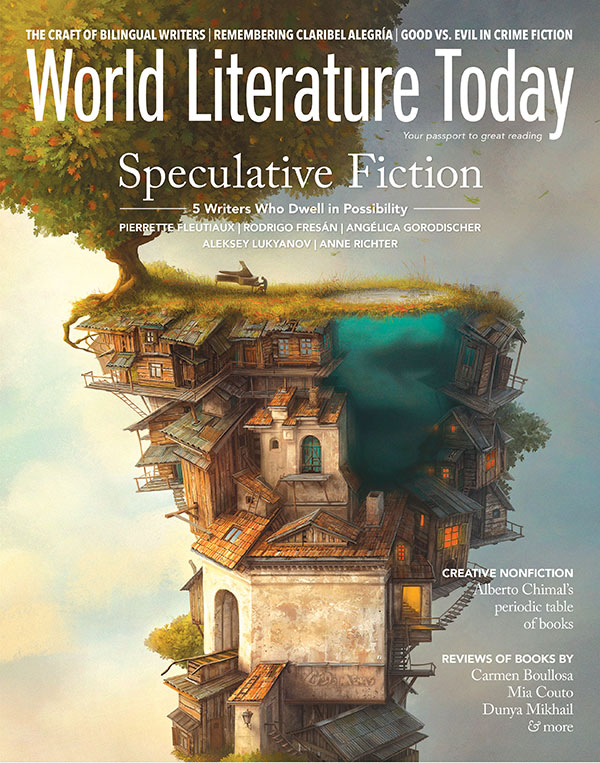Inside the Bilingual Writer
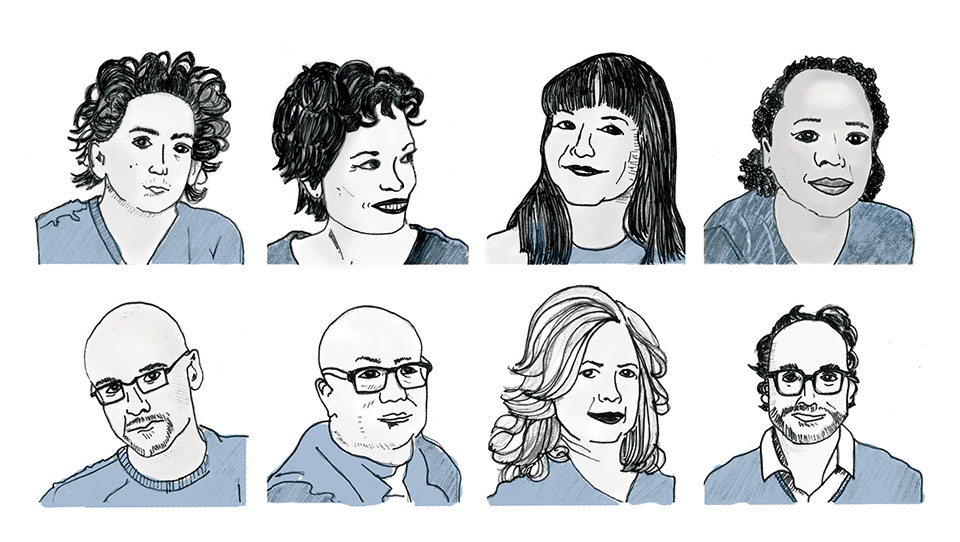
Through a series of interviews, Erik Gleibermann explores how eight prominent bilingual US writers approach their dual-language craft as they navigate identity between a childhood lived in one tongue and adulthood lived in another.
“When I live in both languages at the same time, it’s like breathing.” – Esmeralda Santiago
W
hen Edwidge Danticat was composing “A Wall of Fire Rising” in her 1995 short-story collection Krik? Krak!, internally she heard her characters speaking Haitian Creole, Danticat’s childhood language. A distressed married couple talks about whether to consign their young son to work at a sugar mill where for months, the husband has been turned away. In his pain, he dreams of escaping Haiti in a hot-air balloon lying idle beside the mill. His wife tells him that “if God wanted people to fly, he would have given us wings on our backs.” He replies, “You’re right, Lili, you’re right. But look what he gave us instead. He gave us reasons to want to fly. He gave us the air, the birds, our son.”
Danticat wrote these lines and the rest of Krik? Krak! in English over ten years after leaving Haiti for New York at age twelve. English had become her dominant language and the medium of her writer self, while Creole preserved life’s underlying roots.
In a recent interview Danticat told me how years after writing “A Wall of Fire Rising” she returned to those roots, adapting the story into Creole for a Haitian radio broadcast. “I felt closer to how I felt the story as a child,” she said. She was elaborating on a reflection about the story in her essay collection Create Dangerously: The Immigrant Artist at Work (2011), in which she says, “It was as if the voice in which I write, the voice in which people speak Creole that comes out English on paper, had been released, and finally I was writing for people like my Tante Ilyana . . .”
Danticat’s dance between languages, and between selves, illustrates the creative artistic and identity flow many bilingual writers experience. I spoke with Danticat and seven other bilingual writers now living in the United States to discover how each crafts between languages. The others included Sandra Cisneros, Junot Díaz, Daniel Alarcón, Julia Alvarez, and Esmeralda Santiago (Spanish), Ha Jin (Chinese), and Gary Shteyngart (Russian). Each engages in a distinctive artistic process. Santiago, for example, composes simultaneously in Spanish and English. Shteyngart sprinkles in Russian when drawing from childhood memories. Jin inflects English with a slightly alien tone to remind readers his characters are actually speaking Chinese. But while the crafting processes differ, the search for personal identity is often quite similar. Like Danticat, many of these writers have found their work to be a powerful means for navigating identities along the intimate boundary between a childhood of one tongue and an adulthood of another. Traveling back and forth can be a journey of both reconciliation and conflict.
In living this duality, these writers voice the daily experience of many bilingual immigrants around the world who are cooking breakfast, attending staff meetings, posing questions in class, and buying the week’s groceries. Collectively, bilingual writers play a formative cultural role in the United States, reflecting the lives of a growing community. In 2015, 37 million people or 12 percent of the population spoke two languages, an increase of 11 million since 2000. The greatest number by far speak Spanish, followed by Chinese and Tagalog (census.gov).
Many of these writers have found their work to be a powerful means for navigating identities along the intimate boundary between a childhood of one tongue and an adulthood of another.
These writers’ voices are especially vital now because they counter the current anti-immigrant backlash. While the Trump administration does not explicitly negate non-English languages, it targets them implicitly through the proposed Mexican border wall, revocation of DACA, and travel restrictions against eight countries with non-English primary languages. It has even removed the White House Spanish website.
Many of these writers are immigrants who arrived as children young enough to make English their dominant language, except for Jin, who left China for Boston at twenty-nine, and Cisneros, who grew up bilingual in Chicago. Alarcón came from Peru at three, Díaz from the Dominican Republic at six, Shteyngart from Russia at seven, Alvarez from the Dominican Republic at ten, and Santiago from Puerto Rico at thirteen. Other bilingual writers have had a similar history, such as Khaled Hosseini (Farsi), Laila Lalami (Arabic), Andrew Lam (Vietnamese), Kao Kalia Lang (Hmong), and Elif Shafak (Turkish). Still others, such as Viet Thanh Nguyen (Vietnamese), Chang-rae Lee (Korean), and Jhumpa Lahiri (Bengali) have had more indirect connection to the second language, not speaking it regularly as children.
For those who work directly between languages, the process sometimes begins unconsciously, without even transferring visibly to the page. Cisneros told me that while she wrote her lyrical coming-of-age novella The House on Mango Street, she was not aware of the subsurface presence of Spanish. “I was thinking in Spanish and writing in English,” she said. “It was there underneath like an archaeology.” Over the years she brought Spanish more consciously into her process, telling me that now “I always feel like I’m on a borderland.”
For Shytengart, Díaz, and Santiago, the play of languages in sleep emerges to inform how characters speak in story. “If the people in my dream are Spanish-speakers,” Díaz said, “they speak to me in Spanish. As with my dreams, my writing. English and Spanish exist in me side-by-side, twin rivers of different size, mostly separate but sometimes confluent.” Díaz comfortably transfers his immigrant childhood experience lived in Spanish into English. “I didn’t know English when I first moved to New Jersey,” he said, “but that didn’t stop me from bearing witness to those terrible first years, which I now recount in a language that at the time I did not possess.”
For those who work directly between languages, the process sometimes begins unconsciously, without even transferring visibly to the page.
To get an angle on Díaz, I trained a lens on his expletives because they are such a potent element of his dialogue. What does it mean if a character says mierda rather than shit, cabrón instead of asshole? Because his texts are almost entirely in English, when a Spanish word or phrase appears, it can highlight and intensify a moment, often with playful sexuality. In the short-story collection This Is How You Lose Her, the narrator Yunior’s brother tries to justify having an affair, saying to their mother, “Se metió por mis ojos” (She took me through my eyes). The mother responds wryly, “Por mis ojos my ass. Tu te metiste por su culo” (Through my eyes, my ass. You took her through her ass). This salacious bilingual wordplay creates a loose intimacy that accents the conflicted family bond. Similarly, in another family moment, Yunior’s brother, feeling judged for his womanizing, tells Yunior, “Cállate la fucking boca” (Shut your fucking mouth). Here, the Spanglish could be read as either casualizing fraternal repartee or accentuating the angry edge.
While Díaz displays Spanish and English interweaving, Jin explained how English and Chinese for him operate almost through separate channels. “I think in English, but I hear in Chinese,” he said. Though twenty-nine when he immigrated, Jin chose to write his novels and stories in English and attended the Boston University MFA program, which he now directs. While he has a well-attuned ear for English idiom, he told me that in his novels and short stories he wants his Chinese-speaking characters to sound slightly dissonant so the reader senses they’re not speaking English. Sometimes he does this by translating Chinese figurative language literally. He gave an example from his 2016 novel The Boat Rocker, where a character uses the common Chinese expression “A lie the size of heaven.” On the other hand, working with the complex connotations of poetry, Jin said he usually prefers to write in his native Chinese. “I need to feel the full weight of the language,” he said. “With Chinese, I still can have this feeling, which has gradually been shifting to English.”
When the writers dip into the well of their childhood languages, the vocabulary in context feels anything but neuter.
While Jin is the only one of the writers who regularly composes in two languages, Santiago is the only one who actually writes bilingually in the moment. “It’s spontaneous,” she explained. “Early drafts of all my books are a mélange of English and Spanish, with whole pages in Spanish then translated to English toward the final drafts. I go from English to Spanish in midsentence when drafting. It feels as if that mixture is my real language.”
Alarcón, in contrast, is the only writer working out loud in one language and compositionally in the other. A journalist as well as fiction writer, he researches and interviews in Spanish, primarily in his native Peru. He wrote an investigative essay for Harper’s on life in Peru’s largest prison, which also served as the basis for his fictional prison settings.
Because he immigrated to the US at age three, Alarcón spoke limited Spanish growing up. Along with Jin, he has had to train himself to employ his nondominant language and marks his rite of passage into literary Spanish at age twenty when he read García Márquez’s One Hundred Years of Solitude in the original. Now he immerses himself in Spanish, spending long periods in Lima, directing a Spanish-language podcast, Radio Ambulante, and publishing nonfiction pieces in a Peruvian magazine he co-edits. But Alarcón chooses not to splice Spanish into his English texts. He contrasted himself with Díaz. “It didn’t make sense for me to approach Spanish in the way he did. He’s writing about a lived bilingual experience.”
Alarcón, however, incorporates translated Peruvian vernacular. “If I’m writing a conversation between a father and a son about love, sex, travel, money, or whatever, I’m translating from Peruvian Spanish. How you translate is so situational. In English, you’re not going to translate something into deep Brooklynese.” He had two translations done of his novel City of Clowns, one in Peruvian Spanish for a Peruvian audience, and the second in a neuter Spanish for a US audience. He said the latter is bland and unrooted to any particular community but necessary for the multinational Spanish population in the US.
When the writers dip into the well of their childhood languages, the vocabulary in context feels anything but neuter. It is deeply immersed in the personal phrasings of family intimacy, whether harmonious or conflicted. Like Díaz, Danticat builds tension around family interaction using slivers of the second language. In her 2017 short story “Sunrise, Sunset,” for example, she sparingly employs three Creole words to intensify two mother-daughter moments. In the first, an Alzheimer’s-stricken grandmother dangles her granddaughter over a balcony, while the mother, Jeanne, beseeches her to pull the baby back. Jeanne pleads with two separate words for please: souple and then tanpri. At the end, they have a second strained moment when Jeanne tells her mother, now being carted away on a gurney, “Mesi” (thank you), less in gratitude than in farewell.
Even today, some of the writers seem vulnerable, still caught between tongues, English remaining slightly alien even as it has been a primary voice.
Danticat depicts another poignant mother-daughter moment in her children’s picture book Mama’s Nightingale. The young narrator, Saya, misses her mother who has been jailed as an undocumented immigrant. Late at night when everyone is asleep, Saya listens to her mother’s outgoing voicemail message. “Tangri kite bon ti nouvél pou nou!” the voice says in Creole. “Please, leave us good news!” The reader can feel Saya’s spirits momentarily lift.
The way that bits of Creole, Spanish, or, in Shteyngart’s case, Russian, invoke early life emotions is what Cisneros calls “the spell of words spoken in the language of our childhood.” Like Danticat writing a Creole that awakens the spirit of her Tante Ilyana in Haiti, Shteyngart finds Russian animating memories of living with his father in Moscow. He told me he usually thinks in English while writing, but for his memoir Little Failure, he often thought in Russian. Russian carries both the pain and joy of Shteyngart’s turbulent relationships with his parents. His childhood nicknames included Solnyshko (Little Sun), Soplyak (Snotty), and the titular Failurchka (Little Failure). At one point, the father declares a sadistic Russian wisdom: “Tot kto byot, tot ne lyubit, my father likes to say. He who doesn’t hit, doesn’t love.”
In a course he teaches at Columbia University, Shteyngart traces the development of immigrant literature, perhaps the core subcategory of bilingual writing. He said the kind of inner cultural tension he shows in Little Failure is a relatively recent literary theme. “Earlier American immigrant literature was about the American dream and assimilation,” he said. “Now it’s more about loss and ambivalence.” Early in his course he teaches Vladimir Nabokov’s novel Pnin, which satirically portrays a Russian college professor enchanted by American life. Toward the end of the course, students transition to Díaz’s short-story collection Drowned, in which Yunior also appears as narrator, coping with the strains of his family’s immigration from Santo Domingo.
Shteyngart, Santiago, and Alvarez all use bilingual strategies to express the tensions and growing pains of assimilation in which English becomes a complex source of disorientation, shame, fascination, and power. In Little Failure, Shteyngart recounts the shame of being demoted a grade because of his poor English and, when he later becomes interested in girls, fears that saying “‘Oh, hi there’ in his Russian accent will sound like “Okht Hyzer.”
In her memoir Almost a Woman, Santiago inserts a question in Spanish, recounting how on her third day in Brooklyn after arriving from Puerto Rico, a young girl skips rope to her side and asks, “Tu eres hispana?” (Are you Hispanic?). Though the words are Spanish, it’s an English-derived racial designation that Santiago has never heard before. She suddenly feels her Puerto Rican self invisible, absorbed into a vague collective identity.
“She redefined who I thought I was,” Santiago reflected, “by suggesting the process of flying across the ocean had transformed me into someone else. That had profound implications for my developing sense of self.”
In her poetry collection The Woman I Kept to Myself, Alvarez explores how she embraced English and disowned Spanish to assimilate. In “All-American Girl,” she writes, “I practiced foreign faces, Anglo grins, / repressing a native Latin fluency / for the cooler mask of English ironies. / I wanted the world and words to match again / as when I had lived solely in Spanish.”
Even today, some of the writers seem vulnerable, still caught between tongues, English remaining slightly alien even as it has been a primary voice. In our conversations, Alvarez and Danticat independently cited the epigraph to Drown that Díaz quotes from Cuban American writer Gustavo Pérez Firmat: “The fact that I am writing to you in English already falsifies what I wanted to tell you. My subject: I don’t belong to English, though I belong nowhere else.” In Create Dangerously, Danticat simply calls English “This language that is not mine.”
Alvarez said that she cannot fully own her native tongue, a painful loss. “It really hurts sometimes when I’m in the Dominican Republic,” she said. “It’s a yearning for something lost. I can play in English in a way I’ve lost in Spanish.” In her memoir Something to Declare, she recounts feeling inarticulate with a first boyfriend on a summer trip back to the island. She points out the Big Dipper to him and the only words she can think of translate as “the big spoon,” a seemingly small vocabulary gap, but one that for Alvarez signifies diminished intimacy. She referred to a similar emotional distance in Cisneros’s Spanglish short story “Bien Pretty,” whose narrator longs to make love in a Spanish she feels unable to embody.
One could read Alvarez’s novel How the Garcia Girls Lost Their Accents as a narrative wish to reclaim her childhood Spanish voice because the story is told in reverse chronological order, beginning with four sisters after they have lived their adulthood speaking English in New York, then tracing them back to their Dominican childhood.
When they attended MFA programs (all eight have MFA degrees), the writers were often not encouraged to draw from their childhood language, and the reading lists generally lacked bilingual models. Alvarez was pointed. “I was silenced,” she told me about her early writing. “One writer read my first book, Homecoming, and didn’t even know I was Latina. I’d written the word ‘mother’ throughout, so I changed them all to mami. I didn’t know you could do that.” But even as Alvarez eventually worked to reclaim Spanish, she has talked about being judged in the Dominican Republic for writing only in English. In Something to Declare, she describes how at a conference in Santo Domingo a renowned Dominican writer said publicly, “It doesn’t seem possible that a Dominican should write in English. Come back to your country, to your language.”
According to Danticat, that choice to write in English can bring severe judgment. “I think people pathologize it,” she said, suggesting critics see the exclusive use of English as a kind of self-negation. She said it can become a double bind when writers like her selectively integrate non-English vocabulary. Then “people will accuse you of exoticizing or flavoring.”
Danticat said that growing into bilingual maturity is both a personal healing and an artistic process in which “we have to start with our own acceptance of our own language.”
The writers often model this process for each other. “I learned a lot from Julia and Sandra,” Danticat said, “how they used Spanish. I learned from them the rhythms of another language. They taught me how not to censor myself.” Though they may have grown up living different languages, often there is a kinship among bilingual writers. In reference to Danticat’s first novel and their shared Dominican–Haitian border, Alvarez said, “reading Breath, Eyes, Memory was so meaningful for me. It was the other side of the island and she was the sister I’d never known.”
At the end of our conversation I asked Alvarez what the extended family of bilingual writers might offer a young protégé just finding her voice. “I’d give her everyone’s stories,” she said. “I’d say this is the big circle and you’re invited. You’ll realize there’s only one story.”
San Francisco




